The fifth in my series about UNESCO sites off the beaten track takes us to North, South and Central Americas and the Caribbean. My fellow bloggers have helped me produce the following list of unusual UNESCO sites in The Americas and the Caribbean.
What you can expect in this post:
*This site uses affiliate links and I may earn a small commission when you use my links and make a purchase without incurring an additional fee yourself.
Thank you for supporting this website. See my disclaimer page for more details.
Lesser-known UNESCO sites in The Americas & Caribbean
Nelson’s Dockyard, Antigua
by Larch from The Silver Nomad

Down in the south of Antigua in English Harbour is Nelson’s Dockyard. The Dockyard has been preserved and many of the colonial buildings have been preserved, though now many are used as museums, shops or restaurants.
The dockyards started life in the early 1700s and were built by African slaves. It was a safe harbour for the Royal Navy who were protecting the valuable sugar that the Western Islands was producing. It also became a refuge from hurricanes and for careening ships which entailed tipping them on their side to clean.
Lord Nelson, who the dockyards are named after, was temporary Commander of the Leeward Island Stations from 1784 to 1787 and helped defend the British sugar and spice cargos from Spanish, Portuguese and French.
Most of the buildings that you see today were actually built between 1785 and 1792, but by 1889 the Royal Navy had abandoned the dockyards and they fell into disrepair. The Friends of English Harbour started the extensive reconstruction of the buildings in the 1950s. The restored Dockyard was then officially reopened in 1961.
The harbour is still used today, not only as a tourist attraction but also as a harbour for private sailing boats and yachts.
The admission is $8USD which includes entrance to the Dow’s Hill Interpretation Centre which offers stunning views over the harbour as well as a multimedia exhibition charting the island’s history from the American Indian inhabitants to the British colonialism right up to the present times.
Brimstone Hill Fortress, St. Kitts
by Annick from The Common Traveler
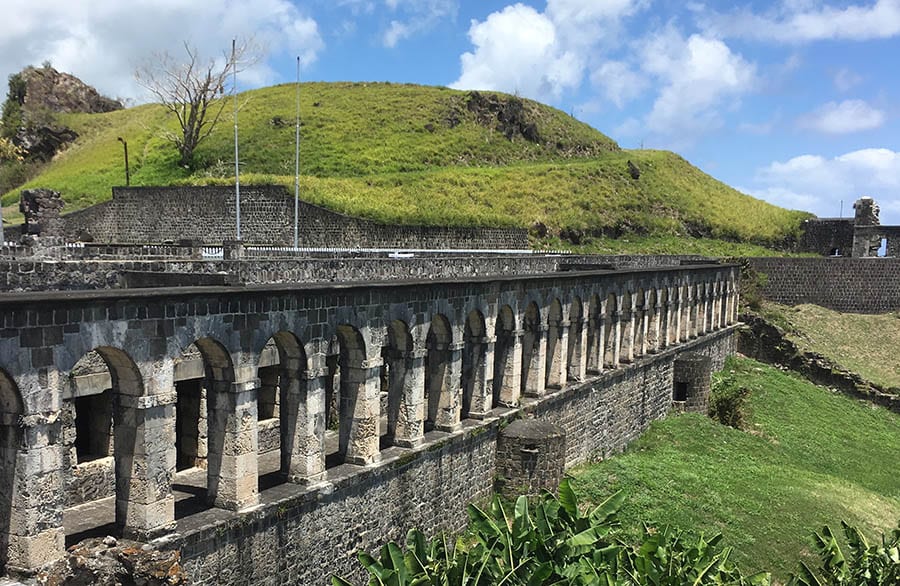
Visitors to St. Kitts shouldn’t miss a visit to Brimstone Hill Fortress. This former British military base protected both the island and the British interests in the Caribbean in the 18th Century. Building on the structure commenced in 1690 and lasted approximately 100 years.
This well-preserved historical site became a UNESCO World Heritage Site in 1999. Considered the “Gibraltar of the Caribbean,” Brimstone Hill was impregnable as the French tried on several occasions to overtake it. The fortress is an architectural feat demonstrating British design in building on rocky terrain by levelling various areas.
Exhibits provide a glimpse into what life was like in 18th century military communities. In addition to the planning skills demonstrated by the architects, the fortress shows great use of local resources as the structure is mainly composed of the hardened volcanic rock mortared with local limestone. Abandoned in 1853, it reopened in 1973 after restoration began.
A $10 admission fee is required. The tour starts with a short movie and visitors then explore the site on their own. A small restaurant provides a good stopping point for those looking for a refreshment or meal while sightseeing the island.
Whether you’re a fan of Caribbean history or not, you can’t fail but admire the beautiful views from this magnificent spot in St. Kitts. You’ll see the fields and woods of the island as well as several neighbouring Caribbean islands. Brimstone Hill Fortress shouldn’t be missed!
YOU MIGHT ALSO LIKE: Unesco Sites Off The Beaten Track – UK
Loreto, Baja Sur, Mexico
by Ed and Jenn from Coleman Concierge

Loreto, a remote town in Baja Sur, is home to one of the most amazing UNESCO sites you probably have never heard of – Bahía de Loreto National Park or the Island of the Sea of Cortez. Isla Coronados, Isla del Carmen, Isla Danzante, Isla Monserrat, and Isla Santa Catalina draw the most visitors to the National Park.
Tourists come for the warm blue water and white sand beaches. But most of all, they come for animals. During the winter months, Blue Whales and Humpbacks migrate here from the arctic. During the summer, whale sharks swim up the coast from La Paz and Cabo San Lucas. However, the most unusual animals are the mobula rays.
The rays swim in huge schools, often numbering in the thousands. Some mornings, for reasons scientists still don’t understand, they jump out of the ocean in mass. It looks like the seas are boiling with the flying and flopping rays.
The town of Loreto does have an international airport, but flights don’t come in every day. It’s less than a day’s drive north of La Paz, and a wonderful stop on a Baja road trip. You’ll find a sleepy Mexican beach town with a classic town square built around the old Spanish mission. Most of all, you’ll discover the magical Islands of Loreto Bay.
Rapa Nui, Chile
by Steph from Worldly Adventurer

Lying 3,700 kilometres west of mainland Chile, the country to which it belongs, Rapa Nui (aka Easter Island) is home to one of the world’s most extraordinary UNESCO World Heritage sites. Nothing quite prepares you for landing on this volcano-dominated island, particularly as you practically land on top of one of the 887 moai for which Rapa Nui is famed.
These stone moai and the ceremonial platforms known as ahu on which they were installed have long fascinated and puzzled archaeologists in equal measure. Basalt mined from a quarry on the island was in turn carved to make these human-shaped monoliths, reflecting the human body from the navel up to the top of an elongated head and weighing in at up to 180 metric tons.
They were carved to honour deceased chiefs and other important tribe members, being moved onto ceremonial platforms overlooking their former villages so that they protect their people, even in the afterlife.
Although all of the moai were toppled during religious disputes on the island in the 18th century, some have been restored to their former glory. You can watch the sunrise behind the backs of the 15 statues at the island’s most impressive site, Ahu Tongariki, hike up around the quarry of Rano Raraku, where all of the moai were carved, or rent a car and explore the length and breadth of the island as you appreciate the incredible artistry and dedication of the Rapanui people.
To enter Parque Nacional Rapa Nui (in which the majority of the sites are located), you need to buy a ticket costing $54,000 CLP ($80 USD) in the arrival’s terminal of the airport.
Colca Canyon, Peru
Colca Canyon is located about 160 kms (100 miles) northwest of Arequipa in the southern part of Peru. It is Peru’s third most-visited tourist destination, but it seemed almost empty when I hiked it. It is one of the deepest canyons in the world, with a vertical depth of over 3,000 metres (over 10,000 ft).
The views from the canyon’s edge and from the hike down are spectacular, but just be aware that this hike is a difficult one. I booked a 2-day hike from Arequipa in a guided group trip, including an overnight stay in a small hotel in the bottom of the canyon, and I highly suggest doing the same thing for a few reasons.
First, the guide explained not only the history of the people and the region but also was able to show us the best places to take photos and video clips.
Second, as part of the tour, we were able to have lunch in one of the small villages at the bottom of the canyon with some locals, which was a great experience and they also booked hotel rooms for us for the night, and there aren’t many options down there to stay the night indoors.
Lastly and most importantly, I was completely exhausted by the long hike on day one and there would be absolutely no way I could hike all the way back up to the top on day two in any reasonable period of time, so they got me and a couple of others on the tour each a donkey to ride back up.
Chan Chan in Trujillo Peru
by Sean from Living Out Lau

Located in the northern part of Peru in the city of Trujillo, Chan Chan is the abandoned capital of the mighty Chimu empire. The Chimus (A.D. 1100-1470) were a group of indigenous people the lived in the area of Trujillo and were later conquered by the powerful Incan empire.
Many people think that Machu Picchu is the biggest ruin in all of Peru, but that is far from the truth. Chan Chan is actually the biggest city in pre-Columbia America. The crazy thing is, this UNESCO site is rarely visited by travellers.
Most of the construction of Chan Chan stayed in its original form because of the seldom rain in that region. Using a type of construction material called the adobe brick, the whole 14 square miles or 36 square kilometres were constructed. In the adobe, you can see many symbols that were relevant in the Chimu culture. For example, you will see carvings of fishes or birds that they believe to be sacred. Usually, it is an animal that was essential in their everyday life, giving them food, clothing, or other essential materials.
If you do plan on visiting, entrance is 11 soles (3.5 USD) and hiring a guide on-site would cost you an extra 30 soles (9USD).
The Pitons, St Lucia
by Kristen from Yonder Lustramblings

If you have ever seen pictures of the Caribbean isle of St. Lucia, more than likely you’ve seen the iconic Pitons looming over its balmy beaches. These lush, tropical sibling peaks make the perfect backdrop to any visit to St. Lucia, rising starkly from the surrounding waters. Not only that but if you wish to get up close and personal with them, you can also hike to the top!
The base of the Pitons can be found near the small town of Soufriere, in southwestern St. Lucia. The tallest of the two, Gros Piton, is just slightly higher than its twin, Petit Piton. These peaks were actually created by volcanic activity, which is still evident in subterranean springs nearby on the island.
If you wish to hike either of these two peaks, there are a few things to know beforehand. Gros Piton is by far the more popular, and more achievable, peak to hike. Petit Piton should only be attempted by those individuals with the fitness training and experience for strenuous summit climbs. Guides are required to hike either peak.
Acquiring a guide to hike Gros Piton is simple. The trailhead for Gros Piton and its interpretive centre can be found in the small town of Fond Gen Libres. There you can find local guides available to lead hikers to the top, starting at around $50 a person. The hike itself is just over 3 miles in length, but due to the difficulty of the ascent, often takes approximately six hours for most to complete. As challenging as it may be to make it to the top, the journey through the rainforest and the views from the top are worth it! From the summit, visitors can view all of St. Lucia, Petit Piton, and even neighbouring St. Vincent!
Mammoth Cave National Park
by Nancy from Checking it off the List
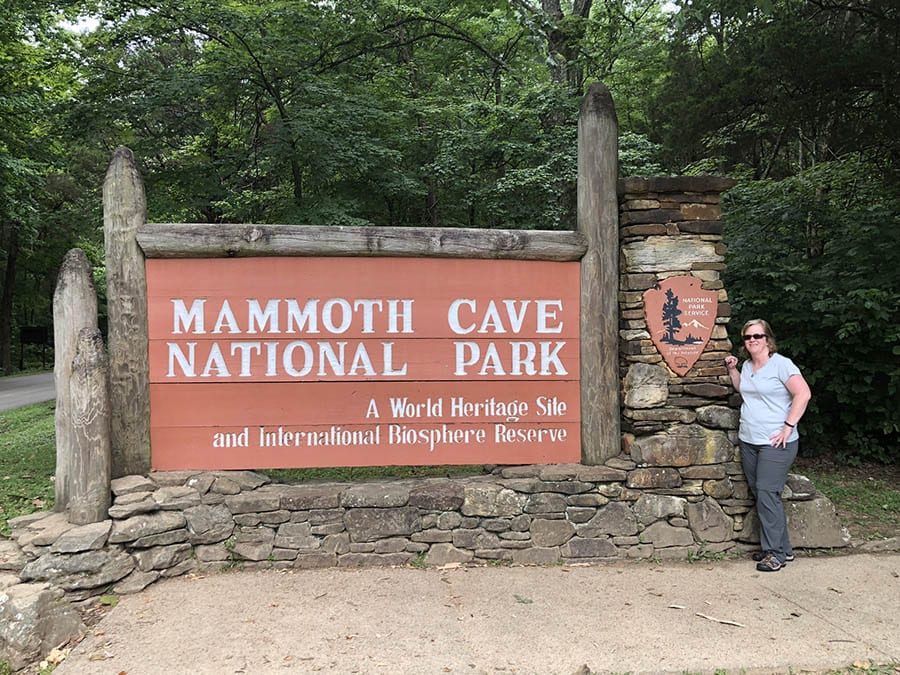
Where is Mammoth Cave National Park
Mammoth Cave National Park is in Kentucky, United States. It is situated approximately 86 miles south of Louisville and 125 miles southwest of Lexington, Kentucky.
The closest city to stay while visiting Mammoth Cave is Cave City, Kentucky which lies just outside the park along Interstate 65.
What makes it special
Mammoth Cave National Park is the largest cave system known in the world. It also provides the best habitat for cave wildlife in the world. To date, researchers and explorers have not been able to find an end to this cave system which currently hosts 400 miles of passageways.
Explore a cave
The most popular activity everyone should do during a visit to Mammoth Cave National Park is taking a ranger-led cave tour. There are many cave tours offerings with varying levels of difficulty and length of time. You can also explore parts of the cave on your own. If you are visiting during a peak seasonal time of year, be sure to book your tour in advance online as tour options can change throughout the year. Tours can range from $14-$60 per person (adult), but entering the park is free of charge. Cost can also vary depending on the time of year.
Hike or bike around the park
Explore the upside of the park by foot or bike on one of the many trails which cover 84 miles through and around the park. Just like the cave tours, there are varying levels of difficulty and length. You can check the National Park website for details.
Kayak through the park
If you do not want to spend all your time on foot, check out an unguided kayaking trip with Mammoth Cave Kayaking on the Green River which runs through Mammoth Cave National Park.
Church of Saint Francis of Assisi, Brazil
by Daniel from Layer Culture
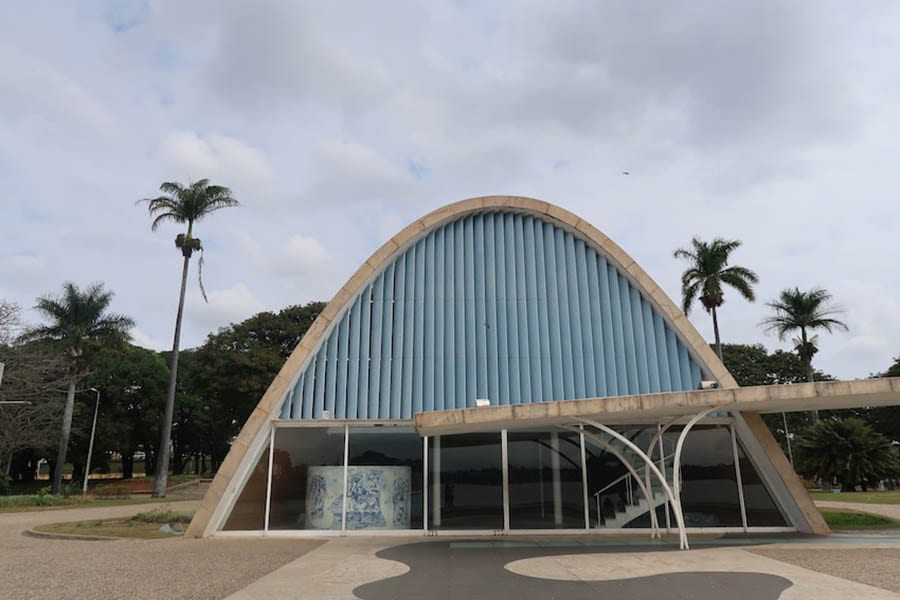
If you ever find yourself in Brazil and looking for the UNESCO sites off the beaten track, then get yourself over to Belo Horizonte in the state of Minas Gerais. Here you’ll find the Church of Saint Francis of Assisi which is one of the first listed modern architectural monuments in Brazil. To get to this UNESCO site is quite simple. Once in Belo Horizonte, head to the bus station and get the local bus over to the Pampulha district. Once there you can get off the bus right outside Church. Designed by Brazilian Architect Oscar Niemeyer, the site is located beside the beautiful Pampulha lake with its peaceful and picturesque surroundings.
The whole area is an important cultural site and one of the most special things about the church is the paintings. Both on the inside and outside of the building you’ll encounter giant wall paintings by Candido Portinari who is one of the most important Brazilian painters of all time. This is the perfect place to fly a drone and you could easily spend half a day walking around the area and discover the many outdoor mosaics that decorate the area.
Lencois, Brazil
by Michael from mscgerber

The Lencois Maranhenses National Park is one of my favourite UNESCO Sites that I’ve ever visited – and yet, some weeks before my visit I’ve actually never heard of it.
My friend from Maranhao, a state in the northeast of Brazil, wrote to me that I should visit her and she will show me around Lencois Maranhenses. After some quick research, I was fascinated by this place and accepted her offer.
And guys, Lencois Maranhenses absolutely blew my mind – it is one of those places that just stuns you with its incredible nature. Lencois Maranhenses basically consists of huge sand dunes that get filled with rainwater during the rainy season – and makes it look unbelievable.
Additionally, you can also do boating tours and safaris in the National Park. To get there, it is recommended to fly into the city of Sao Luis (Maranhao) and then take a bus to the National Park, which takes another 5 to 6 hours.
Lencois Maranhenses is definitely an off the beaten track destination, but in my opinion, so much worth it. After spending one month in Brazil, it was still one of my favourite locations.
YOU MIGHT ALSO LIKE: Unesco Sites Off The Beaten Track – Africa
Colonia del Sacramento, Uruguay
by Erin from Sol Salute
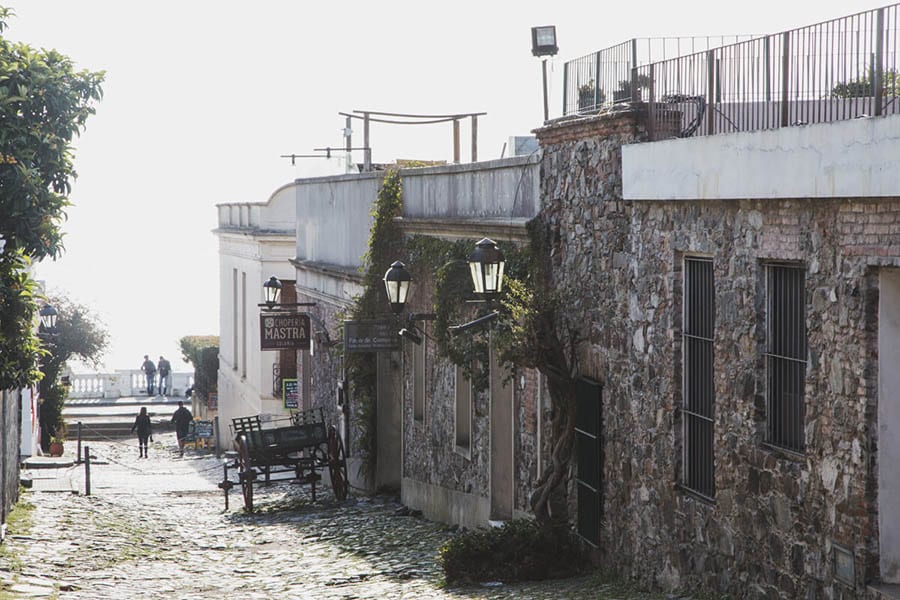
The tiny village of Colonia del Sacramento on the Uruguayan coast is one of the most popular day trips from neighbouring Buenos Aires in Argentina. The entire historic quarter is a UNESCO Heritage Site and it’s easy to understand why as you amble down its cobblestone streets. Colonia was founded by the Portuguese in 1680 and many of the modest one-story buildings are original to that time. Others hail from the 18th and 19th centuries. All are impeccably maintained.
Visiting Colonia del Sacramento from Buenos Aires as a day trip is the most common. Ferries shuttle groups of visitors across the Rio de la Plata twice daily to spend the morning or afternoon in Colonia. The tickets are affordable (usually under $100 US) and usually include a free walking tour. Once there, visitors can relax and enjoy traditional Uruguayan dishes (like chivito) at the countless restaurants in the historic quarter. For only a few dollars you can purchase a ticket to all the museums in town and for a few more dollars you can climb to the top of the lighthouse.
The best way to enjoy a day in Colonia del Sacramento is by doing nothing. Relax and disconnect. Sit at the many waterfront restaurants and enjoy a glass of Uruguayan Tannat and breathe in the crisp air blowing in off the water.
San Antonio Missions, Texas
by Annick from The Common Traveler
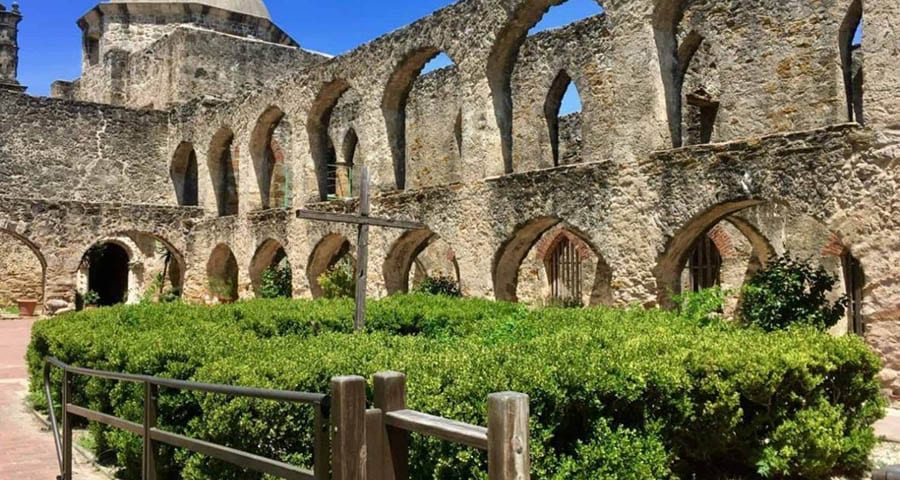
Fans of UNESCO World Heritage Sites travelling in the United States should make sure they include the San Antonio Missions on their travel itinerary. Located in San Antonio, Texas, the missions showcase both the cultural and historical importance of the seventh-largest city in the United States. There are five official missions, Concepcion, San Jose, San Juan, Espada, and the most famous, the Alamo. Each mission offers insight into the people inhabiting this area from the native Indians, to the Spanish, the Mexicans, and eventually, the Texans, who have melded into a pot uniquely Texas.
The five missions can be accessed by trail, car, or bus. The San Antonio Mission Trail is a 15.1 mile loop for those who prefer to visit the sites by bicycle. San Antonio’s Viva bus #40 offers an affordable way to access the missions located farther away from downtown. Each mission showcases the importance of trade, the church, and architecture in making this area prosperous. The grounds of each mission helped to protect those within their walls from the outside strife caused by drought and territorial battles. Serving as a battleground during multiple time periods, visitors learn about the different wars, reliving bits and pieces that led to the eventual cry “Remember the Alamo!”
Maintained by the National Park Service, there is no charge to visit the San Antonio Missions, making them a true national and world treasure.
Sian Ka’an, Mexico
by Cristal from Tofu Traveler

Sian Ka’an is a biosphere reserve found in Quintana Roo, Mexico, just south of Tulum.
Besides being one of the most beautiful places in the Yucatan Peninsula, it’s the third-largest protected area in Mexico. Sian Ka’an is a popular destination for bird watchers and nature lovers in general because you get to a chance to see wildlife right where they belong, in the wild.
Home to manatees, monkeys, crocodiles, Jabiru stork, dolphins, manatees and turtles, you’ll get a chance to spot some or all of these on a boat tour that takes you through the marshes, inlets, mangroves and lagoons of the reserve. Less likely, but still roaming around are ocelots, pumas, jaguars and tapirs.
If you’re looking to get away from it all, consider visiting or spending the night in Punta Allen, a small fishing village located in the reserve. They actually cut the electricity off twice a day so you’ll be forced to disconnect.
It’s the definition of off-the-beaten-track in this region because it’s notoriously difficult to get to. You’ll need to rent a jeep, risk getting stuck in the mud in a local collective or take a day tour. The entrance fee to enter the reserve is 50 pesos (~$2.60 USD).
YOU MIGHT ALSO LIKE: Unesco Sites Off The Beaten Track – Europe
The Historical Fortified Town of Campeche, Mexico
by Wendy from The Nomadic Vegan
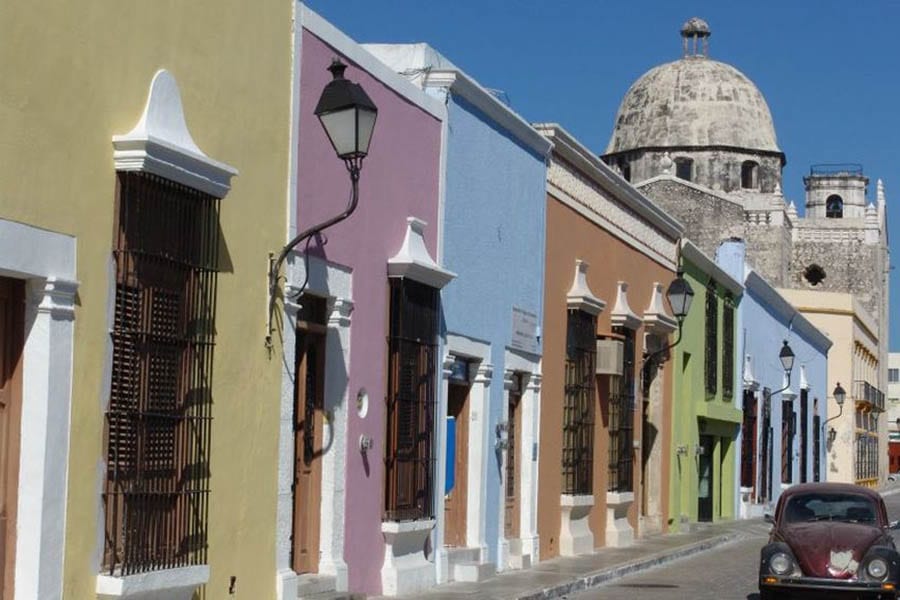
Campeche is the capital of the state of Campeche in Mexico and has a population of about 250,000. It’s made up of the colonial old town, which has been listed as a UNESCO World Heritage Site, and a more modern town built up around it.
The colonial town is notable for its very well-preserved system of fortifications, including city walls and a series of forts. Be sure to check out some of the bastions, called baluartes in Spanish. One of the most enjoyable things to do in Campeche, though, is to just wander the streets aimlessly. Many of the buildings are painted in different pastel colours, making it a very photogenic town. There is no entrance fee to visit the old town itself, as it’s part of a living city, so you’re free to stroll around.
Despite its World Heritage status, Campeche attracts only a fraction of the tourists that visit the nearby Yucatan peninsula each year. There are a few accommodation options around the main plaza, although with so few tourists coming here the market can’t sustain very many hotels.
Nevertheless, I recommend staying somewhere within the historic centre, as from here you will be able to explore all of Campeche’s historical sights on foot. It’s a relatively small and compact town, so nothing is ever too far away, although it’s best to get an early start to avoid the heat of the midday sun, which can be pretty oppressive. You’ll find plenty of small Mom and Pop restaurants in the historic old town too, and even a shop called Natura 2000 that serves vegetarian and vegan Mexican dishes.
YOU MIGHT ALSO LIKE: Unesco Sites Off The Beaten Track – Middle East
Willemstad, Curacao
by Michele from A Taste for Travel
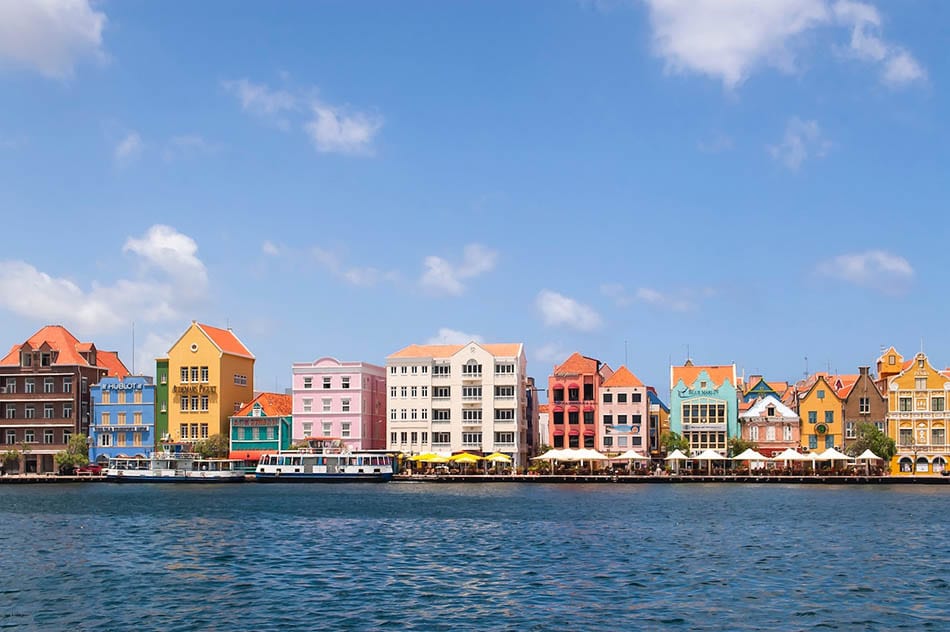
Located on the Dutch Caribbean Island of Curacao, the Historic Zone and Harbour of the capital city of Willemstad has been a designated UNESCO World Heritage Site since 1997. It was selected due to its value as an excellent example of the architecture of a colonial trading and administrative centre.
Originally established in 1634 with the construction of Fort Amsterdam on Saint Anna Bay, the town expanded to form a total of four urban districts over the following centuries. Its beautiful architecture is a unique blend of Dutch European style with Afro-American, Iberian and Caribbean influences.
For today’s visitors, one of the best free things to do in Curacao is to take a guided walking tour of Willemstad’s Historic Zone and learn about the design, materials and craftsmanship of these colourful and carefully-restored buildings. Characteristics to look for in the 17th century Dutch Baroque architectural style include gable roofs, central pediments and steeples. In Willemstad, the buildings’ bright colours of red, blue, ochre, yellow and green are unique to the architectural style, making them an especially popular backdrop for photos.
Antigua, Guatemala
by Tiffany from A Girl and Her Passport
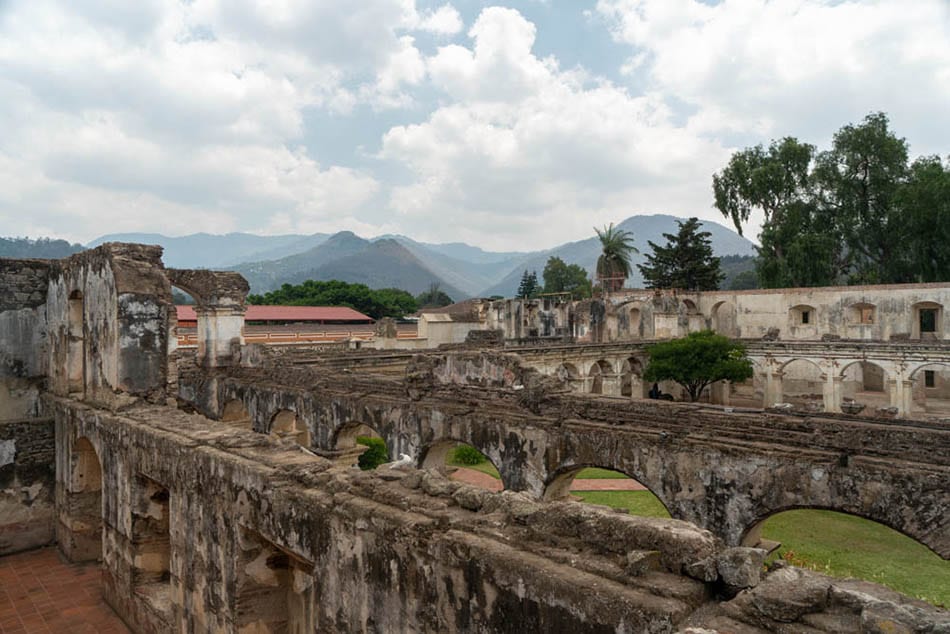
Destructive earthquakes caused Antigua Guatemala to be declared a UNESCO World Heritage site. This was because, after several large earthquakes there in the late 1700s, the country decided to move the capital from Antigua Guatemala to Guatemala City. The town was ordered closed, and not many people remained.
When the people left, the city was preserved as it was after the earthquakes. Many of the large Antigua churches were left in ruins and still remain so today. These churches have been made into landmarks around the city, and you can now visit many of them in their ruined state.
Antigua is laid out in a grid pattern, and the architecture is Spanish inspired. The houses you see now are original and have been restored. Even newer homes are built in the same style.
The other remarkable thing about Antigua is that it is surrounded by three volcanos, two of which are still active today. Volcano de Aqua is visible throughout the town and is dormant. Another volcano is noticeable if you are up high enough, and the day is clear.
Given that the entire city is a UNESCO site, you can easily walk around and see why. There is plenty to explore, and you could spend a week or more exploring all the ruins and seeing the architecture.
YOU MIGHT ALSO LIKE: Unesco Sites Off The Beaten Track – Asia
Taos Pueblo, New Mexico
by Andy from Avrex Travel
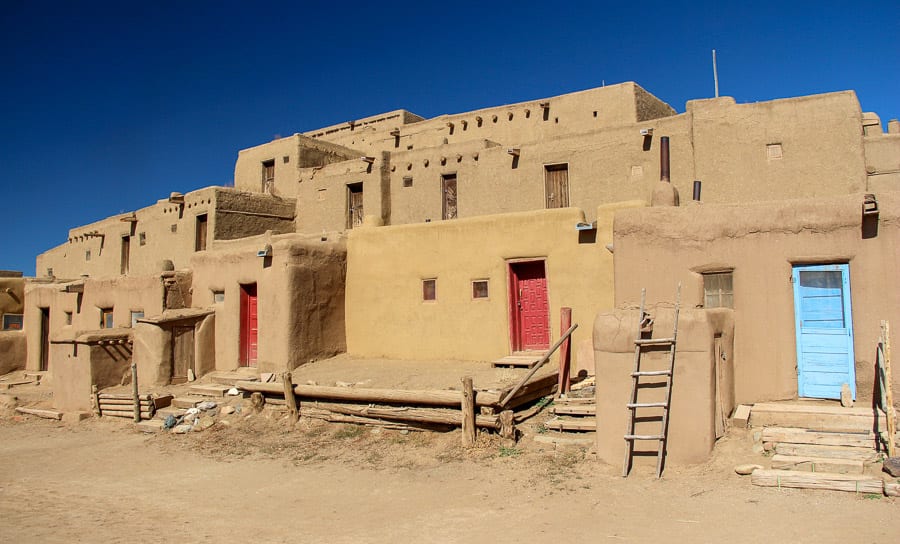
The Taos Pueblo UNESCO World Heritage Site is located just north of Taos, New Mexico, USA. The term Pueblo was given by the Spanish to describe the villages that they found upon exploring this new territory.
This site is unique because the pueblo has been continuously occupied for over 1000 years. Currently, approximately 150 people live in the pueblo, as their ancestors did, without electricity, running water or indoor plumbing.
The site is an adobe-walled village dominated by 2 large multi-tiered adobe structures, much like apartment buildings, the main parts of which are believed to have been built between 1000 and 1450 CE. The Red Willow Creek that runs between these 2 structures provides the sole source of water for the pueblo. The grounds also include a cemetery, the current San Geronimo Catholic Church and the ruins of the first church built after Spanish occupation.
This private Taos community does welcome visitors to their pueblo. An entrance fee allows visitors to view the main areas of the pueblo. A guided tour of Taos Pueblo is provided by native volunteer guides and is highly recommended to learn more about this unique site.
Jesuit Ruins, Paraguay
by Stuart from Stuart Fahy
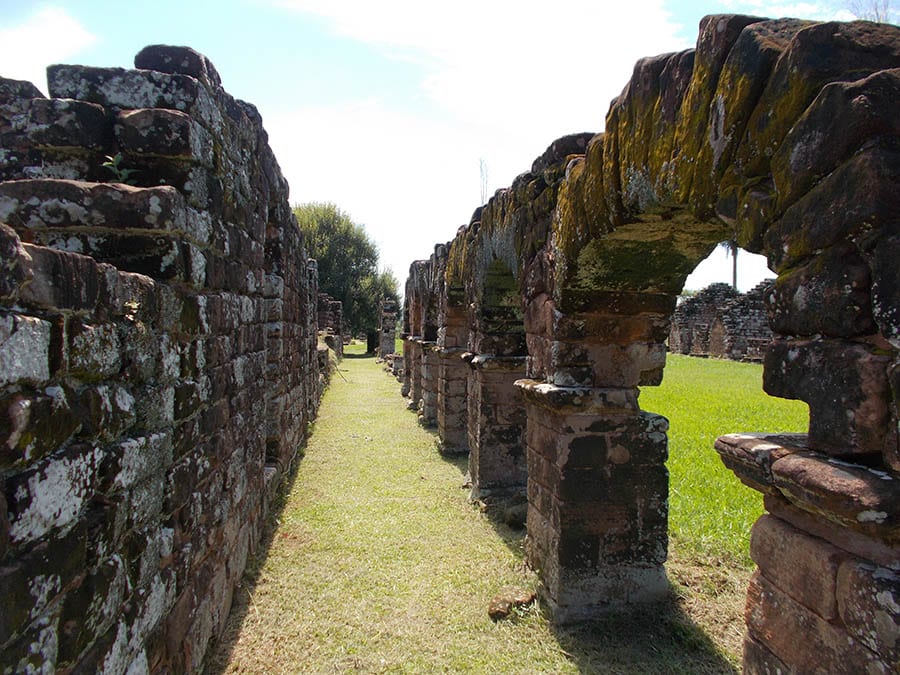
I didn’t realise that Paraguay was less visited than its South American neighbours until I actually visited the area. One reason for this is the lack of tourist attractions. Whilst there are many other reasons to visit Paraguay, the country also boasts a UNESCO site in the Jesuit Ruins at Tavarangue and Trinidad. Located close to Paraguay’s third largest city Encarnación in the South-East of the country, it’s an interesting half-day trip and a great opportunity to see something a little different.
The ruins themselves are what remains of the religious missions established in the area in the 17th century. The Trinidad site was the largest of the missions and you can walk around the old courtyard and see the main altar amongst other buildings. The site is very open and you can wander freely around the ruins, admiring the stone murals and getting a feel of the place as you imagine what life was like for the people who lived there.
Entrance costs 25,000 Paraguayan Guarani (just £3) and that includes access to both sets of ruins plus admission to a small museum and short information film. Around 45km from Encarnación, the ruins are easily accessible by local bus, which you can take from the main bus terminal for 10,000 Guarani (£1.20).
The bus stops on the main road and then it’s just a five-minute walk to the entrance of the Trinidad site. Getting to the Jesús de Tavarangue ruins requires a longer walk or taking a taxi. Usually, motorbike taxis wait at the entrance to Trinidad looking for tourists wishing to visit the other site. Return buses back to Encarnación are every hour or so across the road from the Trinidad site.
Don’t forget to pin this article so you can come back to it later
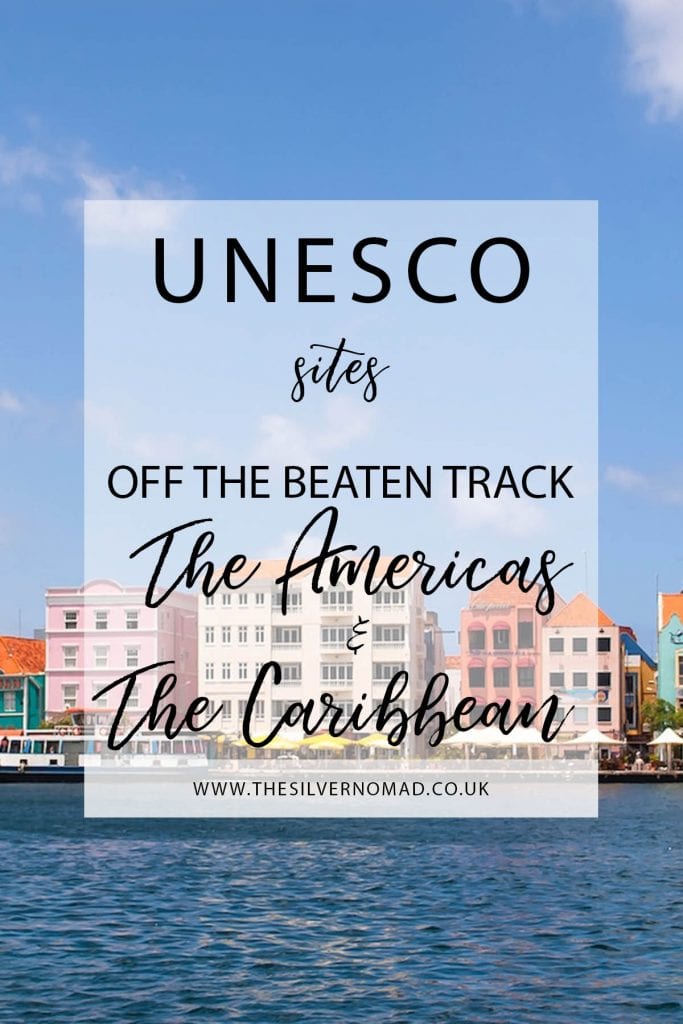

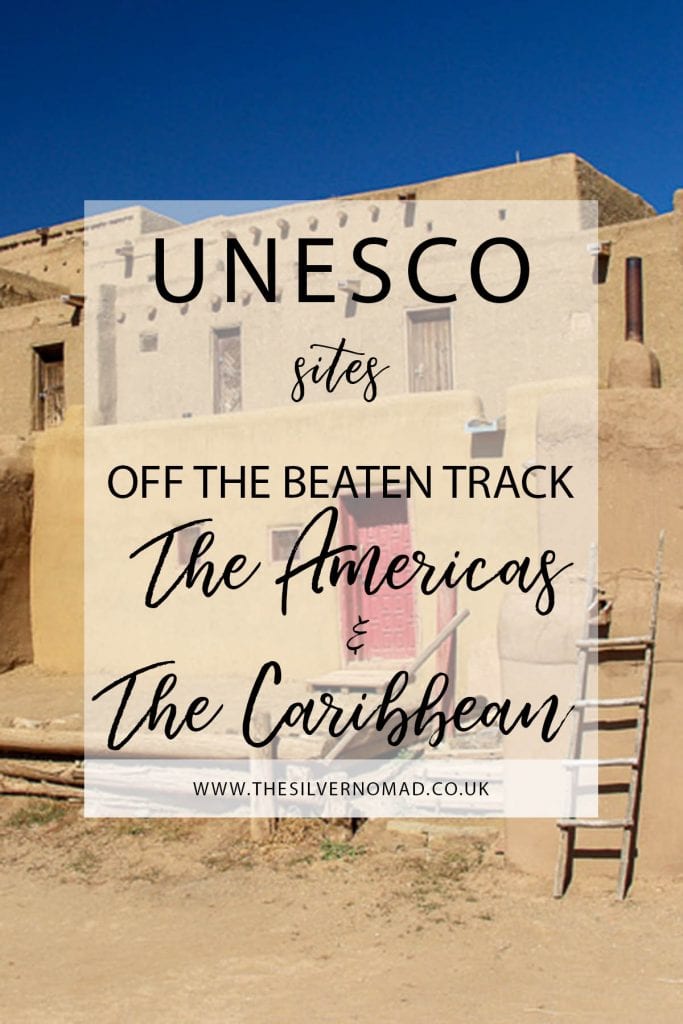

Love all the World Heritage Sites on this list – I’d visit all of them if given the chance!
Hi Danial, yes my visit list keeps getting longer, I will be travelling for the rest of my life before I get to see them all!
I’ve been to Brimstone Fortress in St Kitts – definitely worth a visit. The island is very authentic compared to some Caribbean islands
St Kitts is on my list of places to visit in 2020, though the list is getting a bit crowded!